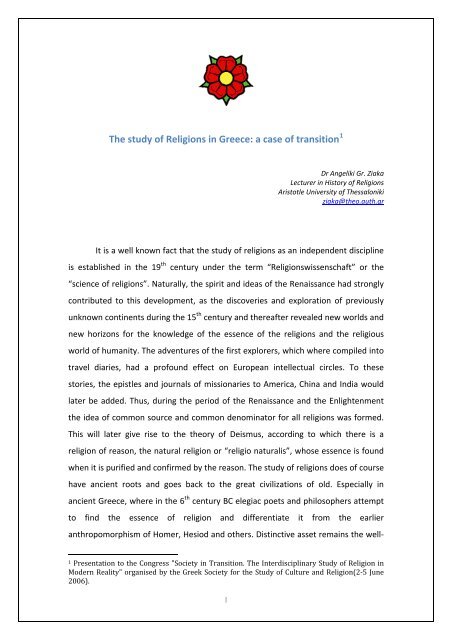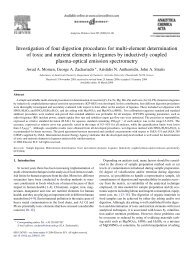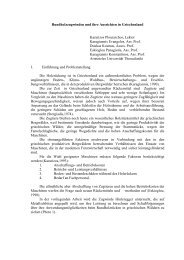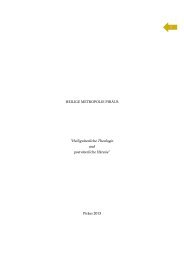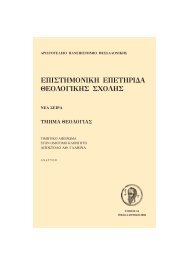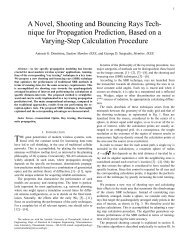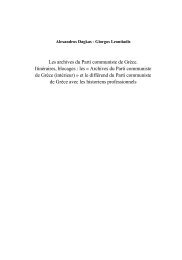The study of Religions in Greece: a case of transition
The study of Religions in Greece: a case of transition
The study of Religions in Greece: a case of transition
You also want an ePaper? Increase the reach of your titles
YUMPU automatically turns print PDFs into web optimized ePapers that Google loves.
<strong>The</strong> <strong>study</strong> <strong>of</strong> <strong>Religions</strong> <strong>in</strong> <strong>Greece</strong>: a <strong>case</strong> <strong>of</strong> <strong>transition</strong> 1<br />
Dr Angeliki Gr. Ziaka<br />
Lecturer <strong>in</strong> History <strong>of</strong> <strong>Religions</strong><br />
Aristotle University <strong>of</strong> <strong>The</strong>ssaloniki<br />
ziaka@theo.auth.gr<br />
It is a well known fact that the <strong>study</strong> <strong>of</strong> religions as an <strong>in</strong>dependent discipl<strong>in</strong>e<br />
is established <strong>in</strong> the 19 th century under the term “<strong>Religions</strong>wissenschaft” or the<br />
“science <strong>of</strong> religions”. Naturally, the spirit and ideas <strong>of</strong> the Renaissance had strongly<br />
contributed to this development, as the discoveries and exploration <strong>of</strong> previously<br />
unknown cont<strong>in</strong>ents dur<strong>in</strong>g the 15 th century and thereafter revealed new worlds and<br />
new horizons for the knowledge <strong>of</strong> the essence <strong>of</strong> the religions and the religious<br />
world <strong>of</strong> humanity. <strong>The</strong> adventures <strong>of</strong> the first explorers, which where compiled <strong>in</strong>to<br />
travel diaries, had a pr<strong>of</strong>ound effect on European <strong>in</strong>tellectual circles. To these<br />
stories, the epistles and journals <strong>of</strong> missionaries to America, Ch<strong>in</strong>a and India would<br />
later be added. Thus, dur<strong>in</strong>g the period <strong>of</strong> the Renaissance and the Enlightenment<br />
the idea <strong>of</strong> common source and common denom<strong>in</strong>ator for all religions was formed.<br />
This will later give rise to the theory <strong>of</strong> Deismus, accord<strong>in</strong>g to which there is a<br />
religion <strong>of</strong> reason, the natural religion or “religio naturalis”, whose essence is found<br />
when it is purified and confirmed by the reason. <strong>The</strong> <strong>study</strong> <strong>of</strong> religions does <strong>of</strong> course<br />
have ancient roots and goes back to the great civilizations <strong>of</strong> old. Especially <strong>in</strong><br />
ancient <strong>Greece</strong>, where <strong>in</strong> the 6 th century BC elegiac poets and philosophers attempt<br />
to f<strong>in</strong>d the essence <strong>of</strong> religion and differentiate it from the earlier<br />
anthropomorphism <strong>of</strong> Homer, Hesiod and others. Dist<strong>in</strong>ctive asset rema<strong>in</strong>s the well‐<br />
1 Presentation to the Congress "Society <strong>in</strong> Transition. <strong>The</strong> Interdiscipl<strong>in</strong>ary Study <strong>of</strong> Religion <strong>in</strong><br />
Modern Reality" organised by the Greek Society for the Study <strong>of</strong> Culture and Religion(2‐5 June<br />
2006).<br />
I
known <strong>in</strong> the scientific research Interpretatio Graeca, applied by Herodotus, “the<br />
father <strong>of</strong> History”, which identified the Egyptian and some other Gods <strong>of</strong> the East to<br />
the Greek ones. Interpret<strong>in</strong>g the religious mythology the ancient greek thought<br />
classified the myths <strong>in</strong> three categories: allegoric, physiocratic and orthological. This<br />
<strong>in</strong>terpretation constitutes a k<strong>in</strong>d <strong>of</strong> <strong>study</strong> <strong>of</strong> religions but not an <strong>in</strong>dependent<br />
discipl<strong>in</strong>e.<br />
All <strong>of</strong> this will lead to the establishment <strong>of</strong> religion as an <strong>in</strong>dependent<br />
discipl<strong>in</strong>e at around 1870. <strong>The</strong> <strong>study</strong> <strong>of</strong> religions aimed to exam<strong>in</strong>e religions as a<br />
whole and discern the similarities and differences which existed between various<br />
forms <strong>of</strong> religion. Its purpose was to provide an objective exhibition <strong>of</strong> the essence<br />
and the historical development and practical issues <strong>of</strong> all religions, not only <strong>of</strong> the<br />
religions <strong>of</strong> its day, but also <strong>of</strong> dead religions. It even aspired to delve <strong>in</strong>to prehistoric<br />
history and <strong>in</strong>vestigate the religious behavior <strong>of</strong> prehistoric man.<br />
Three methods were established for the approach and the <strong>study</strong> <strong>of</strong> the<br />
religious phenomenon. <strong>The</strong> History <strong>of</strong> <strong>Religions</strong>, the Comparative <strong>study</strong> <strong>of</strong> religions<br />
and the Phenomenology <strong>of</strong> <strong>Religions</strong>. <strong>The</strong> History <strong>of</strong> <strong>Religions</strong> is the safer method to<br />
approach the religious experience <strong>of</strong> mank<strong>in</strong>d. This method exam<strong>in</strong>es each religion<br />
separately, accord<strong>in</strong>g to its sources and its monuments and follows its historical<br />
orig<strong>in</strong> and development.<br />
<strong>The</strong> term Comparative <strong>study</strong> <strong>of</strong> religions has been used from the middle <strong>of</strong><br />
the 19 th century (especially from 1890) to the first half <strong>of</strong> the 20 th century and<br />
became the prefer tool to achieve the phenomenon <strong>of</strong> religion. It is <strong>of</strong> course known<br />
that this comparative method was first established by Frïedrich Max Müller, with his<br />
work Essay on Comparative mythology (1856). In this work he compares the Indo‐<br />
European Myths accord<strong>in</strong>g to the Comparative L<strong>in</strong>guistics <strong>of</strong> his time. <strong>The</strong><br />
comparative <strong>study</strong> <strong>of</strong> religions is an hermeneutical method, which ranks religions on<br />
a scale <strong>of</strong> superior and <strong>in</strong>ferior ones. This method followed the Enlightenment and<br />
served the purposes <strong>of</strong> colonization, which depended upon the philosophies which<br />
ranked civilizations as superior and <strong>in</strong>ferior. <strong>The</strong> position <strong>of</strong> Auguste Comte (1778‐<br />
1857) is typical: he would say that only one civilization deserves to be called<br />
civilization, the European one. <strong>The</strong>re are <strong>of</strong> course some other civilizations, as the<br />
Indian and Ch<strong>in</strong>ese ones, but they are far <strong>in</strong>ferior.<br />
II
<strong>The</strong> comparative method started be<strong>in</strong>g questioned <strong>in</strong> the middle <strong>of</strong> the 20 th<br />
century, whereas it is not used nowadays <strong>in</strong> its <strong>in</strong>itial dimension. Instead <strong>of</strong> this, the<br />
term History <strong>of</strong> <strong>Religions</strong> comes <strong>in</strong>to vogue. This method exam<strong>in</strong>es each religion and<br />
attempts to <strong>in</strong>vestigate the genesis, evolution, teach<strong>in</strong>g and worship <strong>of</strong> every religion<br />
and its relationship with society <strong>in</strong> order to <strong>in</strong>vestigate each religion’s <strong>in</strong>fluence on<br />
society and vice versa.<br />
Another method that arose and has a direct connection with the comparative<br />
method <strong>of</strong> religions but attempted to avoid its weaknesses, is the phenomenology <strong>of</strong><br />
religion. This is a method that was developed accord<strong>in</strong>g to the phenomenology <strong>of</strong><br />
Husserl’s philosophy, which had greatly impressed the scholars <strong>of</strong> Europe dur<strong>in</strong>g the<br />
first half <strong>of</strong> the 20 th century. Husserl believed that with the phenomenological<br />
method the philosopher began from the phenomena <strong>of</strong> philosophical thought<br />
reach<strong>in</strong>g likewise to the essence <strong>of</strong> the philosophical thought or idea. In parallel with<br />
the phenomenology <strong>of</strong> philosophy some historians <strong>of</strong> religions reached the<br />
phenomenology <strong>of</strong> religion. In other words they accepted that a researcher, start<strong>in</strong>g<br />
from the religious phenomena that directly affect our conscience can f<strong>in</strong>ally reach<br />
the essence <strong>of</strong> the religion. Guided by a scheme <strong>of</strong> five concentric circles, from the<br />
tangible po<strong>in</strong>ts <strong>of</strong> religions toward its mean<strong>in</strong>gs and ideas, the researcher can arrive<br />
at the <strong>in</strong>conceivable Deus absconditus. <strong>The</strong> ma<strong>in</strong> users <strong>of</strong> this theory (like the<br />
Hollander Gerandus van der Leew [+1950]), employed a completely a‐historic<br />
method <strong>in</strong> their research and exam<strong>in</strong>ed religions as a sum total without tak<strong>in</strong>g <strong>in</strong>to<br />
account their genesis and evolution, compar<strong>in</strong>g like and unlike religious groups<br />
(temples, holy scriptures, symbols, ideas and so on). It was soon seen that this<br />
method disconnects religions from its everyday life, mak<strong>in</strong>g it unlikely that one will<br />
reach the core <strong>of</strong> the religious phenomenon, the deus absconditus. For this reason,<br />
more recent phenomenologists, led by Mircea Eliade (+1986), attempted to connect<br />
phenomenology with history and exam<strong>in</strong>e religions from a historic as well as<br />
typological aspect. <strong>The</strong> ma<strong>in</strong> work <strong>of</strong> Mircea Eliade moves along these two l<strong>in</strong>es <strong>of</strong><br />
research: typology and history <strong>of</strong> religions. However, today a certa<strong>in</strong> distrust <strong>of</strong> this<br />
method is becom<strong>in</strong>g evident, and attempts are made to exam<strong>in</strong>e religions <strong>in</strong><br />
conjunction with the sociological and anthropological method.<br />
III
<strong>The</strong> History <strong>of</strong> <strong>Religions</strong> <strong>in</strong> <strong>Greece</strong><br />
All <strong>of</strong> this will lead to the establishment <strong>of</strong> the <strong>study</strong> <strong>of</strong> religions as an<br />
<strong>in</strong>dependent discipl<strong>in</strong>e. <strong>The</strong> route that the <strong>study</strong> <strong>of</strong> religion followed <strong>in</strong> the European<br />
and North American arenas is well known to the Scholars <strong>of</strong> <strong>study</strong> <strong>of</strong> religions. <strong>The</strong><br />
first tenured position <strong>of</strong> the <strong>study</strong> <strong>of</strong> religions was created <strong>in</strong> 1873 <strong>in</strong> Geneva, whilst<br />
<strong>in</strong> England, historians <strong>of</strong> religions at Oxford and London where already at work from<br />
1871. Those people were well known figures such as Edward Taylor, Andrew Lang<br />
and John G. Frazer. After 1876 four university chairs where created <strong>in</strong> Holland and <strong>in</strong><br />
1879, the first position <strong>in</strong> the Collège de France <strong>in</strong> Paris. In 1885 the Sorbonne<br />
founded a special department for the <strong>study</strong> <strong>of</strong> religions. <strong>The</strong>se changes where swiftly<br />
followed by Brussels <strong>in</strong> 1884, Berl<strong>in</strong> <strong>in</strong> 1910, as well as Bonn, and other European<br />
cities, such as Vienna where Wilhelm Schmidt, who promote, like Andrew Lang <strong>in</strong><br />
England, the theory <strong>of</strong> early monotheism, as well as <strong>in</strong> Louva<strong>in</strong>, where Etienne<br />
Lamotte promotes research <strong>in</strong>to H<strong>in</strong>duism and Buddhism.<br />
Given that this conference is tak<strong>in</strong>g place <strong>in</strong> <strong>Greece</strong>, it is pert<strong>in</strong>ent to follow<br />
this general review with a description <strong>of</strong> the <strong>study</strong> <strong>of</strong> religions <strong>in</strong> the Greek academic<br />
arena. In <strong>Greece</strong>, the <strong>study</strong> <strong>of</strong> religions <strong>in</strong> the Athens Faculty <strong>of</strong> <strong>The</strong>ology was<br />
founded <strong>in</strong> 1931 and the one <strong>of</strong> <strong>The</strong>ssaloniki <strong>in</strong> 1942. It is important to po<strong>in</strong>t out that<br />
the History <strong>of</strong> <strong>Religions</strong> <strong>in</strong> <strong>Greece</strong> is cultivated exclusively <strong>in</strong> the Faculties <strong>of</strong><br />
<strong>The</strong>ology, except some attempts made recently (after 1990) <strong>in</strong> some other faculties<br />
that approach religions, especially Islam, from an anthropological, social and<br />
geopolitical po<strong>in</strong>t <strong>of</strong> view (eg. political sciences e.t.c).<br />
It would be an omission if before the presentation <strong>of</strong> the Study <strong>of</strong> <strong>Religions</strong> <strong>in</strong><br />
Greek Universities, we did not refer to the personality and work <strong>of</strong> Demetrius<br />
Galanos, a great Greek H<strong>in</strong>duist. In the middle <strong>of</strong> the 19 th century, when the<br />
knowledge <strong>of</strong> India began to spread <strong>in</strong> Europe and America, Athens saw the<br />
publication (1845‐1853) <strong>of</strong> a series <strong>of</strong> superb translations <strong>of</strong> Indian poetry and<br />
written texts which had been carried out by Demetrius Galanos. <strong>The</strong> Athenian<br />
Demetrius Galanos departed to India <strong>in</strong> 1786, <strong>in</strong>vited by a Greek merchant <strong>of</strong><br />
Calcutta, Konstant<strong>in</strong>e Pantazis, <strong>in</strong> order to teach Greek to his relatives. Alongside his<br />
six‐year teach<strong>in</strong>g, Galanos devoted himself to the <strong>study</strong> <strong>of</strong> English, Sanskrit, Persian<br />
and other Indian dialects. After successful <strong>in</strong>vestments <strong>in</strong> the larger trad<strong>in</strong>g houses <strong>of</strong><br />
IV
Calcutta, which ensured he could cover all his liv<strong>in</strong>g expenses <strong>in</strong> order to allow him<br />
to devote himself to his studies, he departed for the holy H<strong>in</strong>du city <strong>of</strong> Kāśi (Benares)<br />
where he spent the rema<strong>in</strong><strong>in</strong>g forty years <strong>of</strong> his life, liv<strong>in</strong>g amongst the <strong>in</strong>tellectual<br />
Brahmans <strong>of</strong> his time and absorb<strong>in</strong>g the Indian thought and philosophy. He dies at<br />
Kāśi on the 3 rd <strong>of</strong> May, 1833 at the age <strong>of</strong> 72. He left all his Sancrit texts and hand<br />
written translations to the Academy <strong>of</strong> Athens. He also left beh<strong>in</strong>d a substantial sum<br />
<strong>of</strong> money, which was used for the creation <strong>of</strong> the University <strong>of</strong> Athens. His precious<br />
manuscripts were published as we have already said, between 1845 and 1853 by<br />
G.K. Typaldos, trustee <strong>of</strong> the National Library <strong>of</strong> Athens, and G. Apostolidis, curator<br />
<strong>of</strong> the above mentioned library. Demetrius Galanos is undoubtedly one <strong>of</strong> the first<br />
pioneers <strong>of</strong> H<strong>in</strong>duist <strong>study</strong> <strong>in</strong> Europe, as European H<strong>in</strong>duist scholars <strong>of</strong> the 20 th<br />
century had written, who praised his works.<br />
However, the <strong>study</strong> <strong>of</strong> religions will only beg<strong>in</strong> <strong>in</strong> the Athens Faculty <strong>of</strong><br />
<strong>The</strong>ology <strong>in</strong> 1931 and H<strong>in</strong>duist studies will be promoted <strong>in</strong> their essence <strong>in</strong> 1970. <strong>The</strong><br />
<strong>in</strong>itiator was Nikolaos Louvaris, a pr<strong>of</strong>essor <strong>of</strong> philosophy who saw the <strong>study</strong> <strong>of</strong><br />
religions as a means for one to admire the philosophical thought and the<br />
contemplative search for the holy <strong>in</strong> the religions <strong>of</strong> the world. A real scholar <strong>of</strong> the<br />
<strong>study</strong> <strong>of</strong> religions was encountered <strong>in</strong> the figure <strong>of</strong> Leonidas Filippidis, who took over<br />
the seat <strong>of</strong> religious studies <strong>in</strong> 1936 and drew his attention to certa<strong>in</strong> aspects <strong>of</strong><br />
Indian and Buddhist thought, and authored the studies <strong>The</strong> theory <strong>of</strong> Vedanta on<br />
sorrow and redemption (Athens, 1934) and <strong>The</strong> Highest Moral Ideal accord<strong>in</strong>g to<br />
Buddha (Athens, 1936). S<strong>in</strong>ce he himself did not have knowledge <strong>of</strong> Sanscrit, he did<br />
not cont<strong>in</strong>ue <strong>in</strong> this direction <strong>of</strong> <strong>study</strong>. He did however concern himself with<br />
contemporary issues <strong>in</strong> Europe, such as the Religion <strong>of</strong> Prehistoric Man and Primitive<br />
and Primordial Religion. He also did a significant <strong>study</strong> with the title <strong>of</strong> History <strong>of</strong> the<br />
New Testament Era (Athens, 1958). In this he follows a personal but disputed<br />
method <strong>of</strong> approach<strong>in</strong>g the religions <strong>of</strong> the world – both the exist<strong>in</strong>g and dead ones<br />
– attempt<strong>in</strong>g to prove that all ancient religions until the birth <strong>of</strong> Christ converged<br />
with a general plan <strong>of</strong> God to prepare humanity for the com<strong>in</strong>g <strong>of</strong> Christ.<br />
In more recent decades, Dimitrios Stathopoulos, pr<strong>of</strong>essor <strong>of</strong> History <strong>of</strong><br />
<strong>Religions</strong> <strong>in</strong> the Faculty <strong>of</strong> <strong>The</strong>ology at Athens University, began to look <strong>in</strong>to ancient<br />
Greek mythology. He translated the known work <strong>of</strong> Károli Kerényi History <strong>of</strong> Ancient<br />
V
Greek Mythology, and began to delve <strong>in</strong>to Japanese Buddhism. He is the first to use<br />
scientific pr<strong>in</strong>ciples to <strong>study</strong> this form <strong>of</strong> Buddhism, carv<strong>in</strong>g a road for others to<br />
follow. His work <strong>in</strong>cludes <strong>The</strong> School <strong>of</strong> Pure Country (Jōdo Shū) and its founder<br />
Hönen Shon<strong>in</strong> or Genku (1133‐1212), (Athens, 1990), Zenism, its ancient Evolution<br />
and mean<strong>in</strong>g (Athens, 1997), Ten Degrees <strong>of</strong> Self‐Knowledge, (Athens, 1979).<br />
In essence however, the door towards the <strong>study</strong> <strong>of</strong> Japanese Buddhism and<br />
Sh<strong>in</strong>tō was first established by Stelios Papalexandropoulos, today a pr<strong>of</strong>essor <strong>of</strong> the<br />
<strong>study</strong> <strong>of</strong> religions <strong>in</strong> the Athens Faculty <strong>of</strong> <strong>The</strong>ology. Papalexandropoulos lived and<br />
studied for several years <strong>in</strong> Japan, ma<strong>in</strong>ly <strong>in</strong> Kyoto but also <strong>in</strong> Tokyo, and approaches<br />
the Japanese sources with great ease. Bas<strong>in</strong>g himself ma<strong>in</strong>ly upon the writ<strong>in</strong>gs <strong>of</strong><br />
great teachers <strong>of</strong> Japanese Buddhism and Sh<strong>in</strong>toism he follows the historicalevolutionary<br />
method and observes the orig<strong>in</strong> and development <strong>of</strong> the religious and<br />
social currents <strong>of</strong> Japanese religious life. He authored the follow<strong>in</strong>g studies: <strong>The</strong><br />
Japanese Philosopher Nis<strong>in</strong>ta Kitaro: conditions for the def<strong>in</strong>ition <strong>of</strong> his Buddhist<br />
identity, (Phd, Athens 1992(. Deities and world <strong>in</strong> the world genesis <strong>of</strong> Kontziki,<br />
Athens, 1995), “Christianity and the Far East”, Synaxi 78 (2001) 44‐77. “S<strong>in</strong>to and<br />
ancient Greek religion–similarities and differences”, Love and Confession (Athens,<br />
2001) 201‐214. <strong>The</strong> true reality <strong>in</strong> the work <strong>of</strong> Ndogen. Study <strong>of</strong> Japanese Buddhism,<br />
(Athens, 2002). He also works upon translat<strong>in</strong>g scientific and literary Japanese texts<br />
<strong>in</strong>to the Greek language.<br />
In the area <strong>of</strong> <strong>in</strong>tellectuals two successful diplomats concerned themselves<br />
with H<strong>in</strong>du topics. Vassilis Vitsaxis authored two studies, the first titled H<strong>in</strong>du Epics,<br />
Myths and Symbols (New Delhi, London, New York, 1977) and the second Plato and<br />
the Upanisands (New Delhi, London, 1977). Dimitris Velissaropoulos wrote <strong>The</strong><br />
History <strong>of</strong> Indian Philosophy (Athens, Dodoni Publications, 1975).<br />
In the <strong>The</strong>ssalonikis Faculty <strong>of</strong> <strong>The</strong>ology worked two men. Ioannis Trakas,<br />
who between 1942 and 1960 contributed to the establishment <strong>of</strong> the lesson <strong>of</strong> the<br />
<strong>study</strong> <strong>of</strong> religions, but left no written works. Also, Euaggelos Sdrakas, who between<br />
1964 and 1974 focused on the polemics <strong>of</strong> the Byzant<strong>in</strong>e theologians aga<strong>in</strong>st Islam,<br />
the importance <strong>of</strong> dance <strong>in</strong> certa<strong>in</strong> forms <strong>of</strong> religion and left beh<strong>in</strong>d a manual <strong>of</strong><br />
religions, written accord<strong>in</strong>g to the method that dom<strong>in</strong>ated <strong>in</strong> the <strong>study</strong> <strong>of</strong> religions<br />
circles <strong>of</strong> Europe before 1960.<br />
VI
A broad spectrum <strong>of</strong> the <strong>study</strong> <strong>of</strong> religions based on the modern tendencies<br />
and the demands <strong>of</strong> research will appear <strong>in</strong> the 1970 and thereafter <strong>in</strong> the two<br />
Faculties <strong>of</strong> <strong>The</strong>ology <strong>in</strong> Athens and <strong>The</strong>ssaloniki, from the emeritus now pr<strong>of</strong>essors<br />
Anastasios Giannoulatos, actually Archibishop <strong>in</strong> Albania, and Grigorios Ziakas.<br />
Giannoulatos is the first to promote research <strong>in</strong>to African religions, hav<strong>in</strong>g<br />
worked for several years as a missionary <strong>in</strong> central Africa. In his university lectures he<br />
has covered forms <strong>of</strong> H<strong>in</strong>duism and Buddhism. He is also the first to take significant<br />
steps towards the systematic and scientific research <strong>of</strong> the religion <strong>of</strong> Islam with his<br />
work Islam: an overview <strong>of</strong> the <strong>study</strong> <strong>of</strong> religions. He has and cont<strong>in</strong>ues to contribute<br />
much to the <strong>in</strong>ter‐religious dialogue.<br />
<strong>The</strong> second emeritus now pr<strong>of</strong>essor <strong>of</strong> the <strong>The</strong>ssaloniki Faculty <strong>of</strong> <strong>The</strong>ology,<br />
Gr. Ziakas, bas<strong>in</strong>g himself upon the sources, and work<strong>in</strong>g accord<strong>in</strong>g to the historic,<br />
philological and morphological method, covered a wide spectrum <strong>of</strong> studies about<br />
the history <strong>of</strong> <strong>Religions</strong>. A speaker <strong>of</strong> Arabic, he <strong>in</strong>itially concerned himself with<br />
almost all aspects <strong>of</strong> the Islamic religion and Islamic civilization, such as Islamic<br />
mysticism, Muslim theology and eschatology, the dest<strong>in</strong>ation <strong>of</strong> man accord<strong>in</strong>g to<br />
Islam, as well as the history <strong>of</strong> transmission <strong>of</strong> Greek and Hellenistic thought and<br />
Greek letters <strong>in</strong> the Arab‐Islamic tradition. He also studied the historic path and<br />
evolution <strong>of</strong> the <strong>study</strong> <strong>of</strong> religions and turned his attention towards the religion <strong>of</strong><br />
prehistoric societies and ancient people. He subsequently focused upon the religions<br />
and civilizations <strong>of</strong> Asia (H<strong>in</strong>duism, Ja<strong>in</strong>ism, Taoism, Confucianism, Buddhism, Tibet<br />
and Japan) and wrote many articles upon <strong>in</strong>ter‐religious dialogue.<br />
With these two researchers the circle <strong>of</strong> the “general historians <strong>of</strong> the <strong>study</strong><br />
<strong>of</strong> religions” closes, and the circle <strong>of</strong> specialization beg<strong>in</strong>s. Apart from the<br />
aforementioned scholar <strong>of</strong> Japan at the Athens Faculty <strong>of</strong> <strong>The</strong>ology, Stelios<br />
Papalexandropoulos, the <strong>study</strong> <strong>of</strong> religions at the <strong>The</strong>ssaloniki Faculty <strong>of</strong> <strong>The</strong>ology, is<br />
promoted by the pr<strong>of</strong>essor Panayiotis Pahis, who concerns himself especially with<br />
religions and mysteries cults <strong>of</strong> the Greco‐Roman world and their relationship with<br />
the religiousness <strong>of</strong> the countries <strong>of</strong> the Eastern Mediterranean. His studies cover<br />
many facets <strong>of</strong> the religious life and mystery cult and worship <strong>of</strong> the Greek and<br />
Roman world, such as the Mysteries <strong>of</strong> Eleusis, the Role <strong>of</strong> water and the concept <strong>of</strong><br />
catharsis at the mysteries, the Mysteries <strong>of</strong> Mithras <strong>in</strong> <strong>The</strong>ssaloniki and the greater<br />
VII
Aegean area, the Orgiastic elements <strong>in</strong> the cult <strong>of</strong> Cybel and Attis. <strong>The</strong> microcosmmacrocosm<br />
relations <strong>of</strong> Mithraism, the Religious policy <strong>of</strong> the roman state aga<strong>in</strong>st<br />
Manichaeism, Eastern worship <strong>of</strong> the Greco‐Roman period <strong>in</strong> Rome, Demeter<br />
Karp<strong>of</strong>oros (Fruitbaerer), a <strong>study</strong> that covers the religion and farm<strong>in</strong>g economy <strong>of</strong><br />
the ancient Greek civilization as well as basic studies <strong>of</strong> Isis and the Hellenistic and<br />
Egyptian mysteries. In the <strong>study</strong> <strong>of</strong> religions he follows the historic‐sociological<br />
analysis and criticism <strong>of</strong> the sources <strong>of</strong> the Greco‐Roman world, with special<br />
emphasis on the socio‐historic and economic bases <strong>of</strong> religious life (religion es<br />
system).<br />
<strong>The</strong> speaker, who studied Islamology and the Arabic language, works upon<br />
Islam and exam<strong>in</strong>es the relationship <strong>of</strong> Islam with the Byzant<strong>in</strong>e and post‐Byzant<strong>in</strong>e<br />
world (La recherche grecque contempora<strong>in</strong>e et l’Islam, PhD, University <strong>of</strong> Strasbourg,<br />
2002, ARNT, 2004 ) , as well as the current themes <strong>of</strong> sociopolitical and geopolitical<br />
extensions <strong>of</strong> Islam (Sunnism and Shiism) <strong>in</strong> the Middle East.<br />
In parallel to the <strong>study</strong> <strong>of</strong> religions there exists the sociology <strong>of</strong> religions, the<br />
conclusions <strong>of</strong> which the <strong>study</strong> <strong>of</strong> religions should take <strong>in</strong>to account <strong>in</strong> order to judge<br />
the social phenomenon <strong>of</strong> each religion. Conversely, sociology on its part needs to<br />
consider the conclusions <strong>of</strong> the <strong>study</strong> <strong>of</strong> religions, s<strong>in</strong>ce without knowledge <strong>of</strong> basic<br />
conceptions, <strong>of</strong> the teach<strong>in</strong>gs and evolution <strong>of</strong> a religion we are unable to<br />
comprehend the social manifestations <strong>of</strong> the religious society. <strong>The</strong> same is true for<br />
the anthropology that is practiced outside the sphere <strong>of</strong> theology. At the<br />
<strong>The</strong>ssaloniki Faculty <strong>of</strong> <strong>The</strong>ology, the Sociology <strong>of</strong> Religion is tak<strong>in</strong>g great steps under<br />
the guidance <strong>of</strong> pr<strong>of</strong>essors Vassilios Gioultsis, Ioannis Petrou and Niki Papageorgiou,<br />
scientists with whom we, the scholars <strong>of</strong> the Study <strong>of</strong> <strong>Religions</strong>, feel mutual<br />
understand<strong>in</strong>g and connection. <strong>The</strong> two latter pr<strong>of</strong>essors exam<strong>in</strong>e the new currents<br />
<strong>of</strong> sociology, without underm<strong>in</strong><strong>in</strong>g the essence <strong>of</strong> religious life or submitt<strong>in</strong>g it to the<br />
terms <strong>of</strong> the past or present.<br />
It is worth mention<strong>in</strong>g the work <strong>in</strong> progress <strong>of</strong> the social anthropologist<br />
Gerasimus Makris at the Panteio University <strong>of</strong> Athens. His work exam<strong>in</strong>es forms <strong>of</strong><br />
beliefs and practices <strong>of</strong> Islamic society, and <strong>in</strong> particular aspects <strong>of</strong> the African and<br />
Sudanese Islam. In <strong>The</strong>ssaloniki, social anthropology is promoted by the pr<strong>of</strong>essor<br />
Fot<strong>in</strong>i Tsimpiridou through studies that refer to the position <strong>of</strong> Muslim women <strong>of</strong> the<br />
VIII
East and the sociopolitical extensions. <strong>The</strong> history and literature <strong>of</strong> the Arabic world<br />
<strong>of</strong> the older and newer eras are promulgated <strong>in</strong> the <strong>The</strong>ssaloniki Faculty <strong>of</strong><br />
Philosophy by the pr<strong>of</strong>essor Hassan Badawi and <strong>in</strong> the Athens Faculty <strong>of</strong> Philosophy<br />
by Helene Kondylis. Meanwhile, at the Ioann<strong>in</strong>a Faculty <strong>of</strong> Philosophy pr<strong>of</strong>essor H.<br />
Giannakis works upon a similar issue, and especially the relationship <strong>of</strong> the older<br />
Greek and Arabic philosophy.<br />
In general the methods that are employed <strong>in</strong> the Greek <strong>study</strong> <strong>of</strong> religions are<br />
adapted to the historic nature <strong>of</strong> the subject. <strong>The</strong> purpose <strong>of</strong> the historian <strong>of</strong><br />
religions is to accurately evaluate the historic people and items <strong>of</strong> a religion and<br />
present them as objectively as possible. Today however, the <strong>study</strong> <strong>of</strong> religions does<br />
not cease at the simple historic presentation <strong>of</strong> religious events, but also applies to<br />
the social, political and economic dimensions <strong>of</strong> the religious phenomenon. <strong>The</strong><br />
question <strong>of</strong> the value or truth <strong>of</strong> one religion cannot be set by the <strong>study</strong> <strong>of</strong> religions,<br />
s<strong>in</strong>ce it is not the philosophy <strong>of</strong> religion that approach religion with a certa<strong>in</strong><br />
valuation. <strong>The</strong> philosophical hermeneutic approach, <strong>in</strong> its attempt to penetrate the<br />
mysteries <strong>of</strong> the phenomenon which it studies, can give subjective or even dogmatic<br />
<strong>in</strong>terpretations and arrange religions <strong>in</strong> superior and <strong>in</strong>ferior ones, as was done<br />
dur<strong>in</strong>g the period <strong>of</strong> colonization.<br />
<strong>The</strong> scholar <strong>of</strong> the <strong>study</strong> <strong>of</strong> religions also attempts to avoid syncretism. This<br />
concern a misunderstand<strong>in</strong>g upon certa<strong>in</strong> theologians zealots based themselves<br />
aga<strong>in</strong>st the <strong>study</strong> <strong>of</strong> religions. <strong>The</strong> comparative <strong>study</strong> <strong>of</strong> religions does not mean<br />
syncretism. <strong>The</strong> purpose <strong>of</strong> the scholar <strong>of</strong> the <strong>study</strong> <strong>of</strong> religions is not to isolate<br />
sections <strong>of</strong> certa<strong>in</strong> religions’ teach<strong>in</strong>gs and provide us with a new religious creation,<br />
but to objectively exam<strong>in</strong>e the religious forms <strong>of</strong> each religion and supply us with the<br />
convergence and divergence between each religion. From this po<strong>in</strong>t <strong>of</strong> view the<br />
comparative <strong>study</strong> <strong>of</strong> religions, aga<strong>in</strong>st the hesitation to its use, has its merits. <strong>The</strong><br />
avoidance <strong>of</strong> the comparative <strong>study</strong> occurs either because such a <strong>study</strong> is too<br />
demand<strong>in</strong>g or because it is too <strong>of</strong>ten ta<strong>in</strong>ted with explicit or implicit theological<br />
stances. Naturally, the comparative <strong>study</strong> <strong>of</strong> religions has an ambiguous relationship<br />
with theology, but the careful and consistent scholar <strong>of</strong> the <strong>study</strong> <strong>of</strong> religions has the<br />
capacity to avoid the pitfalls. This is where the beauty <strong>of</strong> the <strong>study</strong> <strong>of</strong> religions lies: it<br />
does not permit the researcher to encapsulate himself <strong>in</strong> dogmatic or explicit<br />
IX
positions. However, we can not ignore the <strong>in</strong>tercultural positions which are created<br />
between religions and civilizations, such as those <strong>in</strong> the Mediterranean and Middle<br />
Eastern regions, where Jews, Christians and Muslims were met and certa<strong>in</strong> forms <strong>of</strong><br />
common civilization, communication and understand<strong>in</strong>g arose.<br />
Today, the students <strong>of</strong> the <strong>The</strong>ssaloniki Faculty <strong>of</strong> <strong>The</strong>ology are taught the<br />
follow<strong>in</strong>g lessons <strong>of</strong> the <strong>study</strong> <strong>of</strong> religions: methods <strong>of</strong> the <strong>study</strong> <strong>of</strong> religions and<br />
history <strong>of</strong> prehistoric societies and ancient people, Religion and the Mystery cults <strong>of</strong><br />
the Greco‐Roman world, religions and civilizations <strong>of</strong> Asia, Islam and <strong>in</strong>ter‐religious<br />
dialogue.<br />
X


